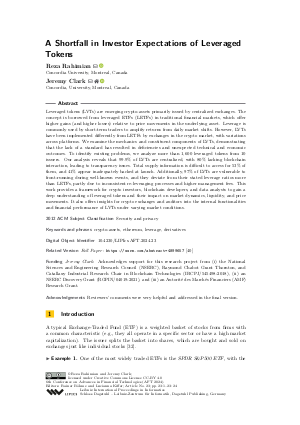A Shortfall in Investor Expectations of Leveraged Tokens
Authors
Reza Rahimian  ,
Jeremy Clark
,
Jeremy Clark 
-
Part of:
Volume:
6th Conference on Advances in Financial Technologies (AFT 2024)
Part of: Series: Leibniz International Proceedings in Informatics (LIPIcs)
Part of: Conference: Advances in Financial Technologies (AFT) - License:
 Creative Commons Attribution 4.0 International license
Creative Commons Attribution 4.0 International license
- Publication Date: 2024-09-16
File

PDF
LIPIcs.AFT.2024.23.pdf
- Filesize: 1.08 MB
- 24 pages
Document Identifiers
Related Versions
- Full Paper https://ssrn.com/abstract=4899657
Subject Classification
ACM Subject Classification
- Security and privacy
Keywords
- crypto-assets
- ethereum
- leverage
- derivatives
Metrics
- Access Statistics
-
Total Accesses (updated on a weekly basis)
0PDF Downloads0Metadata Views
Abstract
Leveraged tokens (LVTs) are emerging crypto-assets primarily issued by centralized exchanges. The concept is borrowed from leveraged ETFs (LETFs) in traditional financial markets, which offer higher gains (and higher losses) relative to price movements in the underlying asset. Leverage is commonly used by short-term traders to amplify returns from daily market shifts. However, LVTs have been implemented differently from LETFs by exchanges in the crypto market, with variations across platforms. We examine the mechanics and constituent components of LVTs, demonstrating that the lack of a standard has resulted in deficiencies and unexpected technical and economic outcomes. To identify existing problems, we analyze more than 1,600 leveraged tokens from 10 issuers. Our analysis reveals that 99.9% of LVTs are centralized, with 80% lacking blockchain interaction, leading to transparency issues. Total supply information is difficult to access for 53% of them, and 41% appear inadequately backed at launch. Additionally, 97% of LVTs are vulnerable to front-running during well-known events, and they deviate from their stated leverage ratios more than LETFs, partly due to inconsistent re-leveraging processes and higher management fees. This work provides a framework for crypto investors, blockchain developers, and data analysts to gain a deep understanding of leveraged tokens and their impact on market dynamics, liquidity, and price movements. It also offers insights for crypto exchanges and auditors into the internal functionalities and financial performance of LVTs under varying market conditions.
Cite As Get BibTex
Reza Rahimian and Jeremy Clark. A Shortfall in Investor Expectations of Leveraged Tokens. In 6th Conference on Advances in Financial Technologies (AFT 2024). Leibniz International Proceedings in Informatics (LIPIcs), Volume 316, pp. 23:1-23:24, Schloss Dagstuhl – Leibniz-Zentrum für Informatik (2024)
https://doi.org/10.4230/LIPIcs.AFT.2024.23
BibTex
@InProceedings{rahimian_et_al:LIPIcs.AFT.2024.23,
author = {Rahimian, Reza and Clark, Jeremy},
title = {{A Shortfall in Investor Expectations of Leveraged Tokens}},
booktitle = {6th Conference on Advances in Financial Technologies (AFT 2024)},
pages = {23:1--23:24},
series = {Leibniz International Proceedings in Informatics (LIPIcs)},
ISBN = {978-3-95977-345-4},
ISSN = {1868-8969},
year = {2024},
volume = {316},
editor = {B\"{o}hme, Rainer and Kiffer, Lucianna},
publisher = {Schloss Dagstuhl -- Leibniz-Zentrum f{\"u}r Informatik},
address = {Dagstuhl, Germany},
URL = {https://drops.dagstuhl.de/entities/document/10.4230/LIPIcs.AFT.2024.23},
URN = {urn:nbn:de:0030-drops-209599},
doi = {10.4230/LIPIcs.AFT.2024.23},
annote = {Keywords: crypto-assets, ethereum, leverage, derivatives}
}
Author Details
Funding
- Clark, Jeremy: Acknowledges support for this research project from (i) the National Sciences and Engineering Research Council (NSERC), Raymond Chabot Grant Thornton, and Catallaxy Industrial Research Chair in Blockchain Technologies (IRCPJ/545498-2018), (ii) an NSERC Discovery Grant (RGPIN/04019-2021), and (iii) an Autorité des Marchés Financiers (AMF) Research Grant.
Acknowledgements
Reviewers' comments were very helpful and addressed in the final version.
References
- Cloud Security Alliance. What is a pseudo cryptocurrency? https://cloudsecurityalliance.org/blog/2019/11/25/what-s-a-pseudo-cryptocurrency/, November 2019. [Online; accessed 16-May-2023].
-
Khalid Husain Ansari and Umesh Kulkarni. Implementation of ethereum request for comment (erc20) token. In Proceedings of the 3rd International Conference on Advances in Science & Technology (ICAST), 2020.

- AscendEX. About ascendex’s leveraged token trading mechanism. https://ascendex.com/en/support/articles/68525-about-ascendexs-leveraged-token-trading-mechanism, May 2023. [Online; accessed 07-May-2023].
-
Carsten Baum, James Hsin-yu Chiang, Bernardo David, Tore Kasper Frederiksen, and Lorenzo Gentile. Sok: Mitigation of front-running in decentralized finance. In International Conference on Financial Cryptography and Data Security, pages 250-271. Springer, 2022.

- Binance. Binance leveraged tokens agreement. https://www.binance.com/en/leveraged-tokens/agreement, May 2023. [Online; accessed 07-May-2023].
- ByBit. Bybit leveraged tokens: A complete get started guide. https://learn.bybit.com/trading/bybit-leveraged-tokens-explained/, May 2023. [Online; accessed 07-May-2023].
- ByDFi. What are leveraged tokens? https://support.bydfi.com/hc/en-us/articles/5692456018319-What-are-Leveraged-Tokens-, May 2023. [Online; accessed 07-May-2023].
-
Andrew Carver. Do leveraged and inverse etfs converge to zero? Institutional Investor Journals Guide to Exchange Traded Funds, 2009, January 2009.

- Narat Charupat and Peter Miu. The pricing and performance of leveraged exchange-traded funds. Journal of Banking & Finance, 35:966-977, April 2011. URL: https://doi.org/10.1016/j.jbankfin.2010.09.012.
- James Chen. Open-ended fund: Definition, example, pros and cons. https://www.investopedia.com/terms/o/open-endfund.asp, December 2021. [Online; accessed 02-Jun-2023].
-
Minder Cheng and Ananth Madhavan. The dynamics of leveraged and inverse exchange-traded funds. Journal of investment management, 16(4):43, 2009.

-
Minder Cheng and Ananth Madhavan. The dynamics of leveraged and inverse exchange-traded funds. Journal of Investment Management, 7, January 2010.

- Index Coop. How composability powers fli tokens. https://indexcoop.com/blog/how-composability-powers-fli-tokens, September 2021. [Online; accessed 17-May-2023].
- The Index Coop. Flexible leverage index. https://indexcoop.com/products/eth-flexible-leverage-index, May 2023. [Online; accessed 07-May-2023].
- Sunflower Corporation. What are leveraged tokens? https://medium.com/coinmonks/what-are-leveraged-tokens-639fb186744a, August 2022. [Online; accessed 09-Jun-2023].
- Gateway To Crypto. Etf leveraged tokens. https://www.gate.io/etf, May 2023. [Online; accessed 07-May-2023].
-
Luke DeVault, Harry J Turtle, and Kainan Wang. Blessing or curse? institutional investment in leveraged etfs. Journal of Banking & Finance, 129:106169, 2021.

-
Tim Dulaney, Tim Husson, and Craig Mccann. Leveraged, inverse, and futures-based etfs. SSRN Electronic Journal, July 2012.

-
Shayan Eskandari, Seyedehmahsa Moosavi, and Jeremy Clark. Sok: Transparent dishonesty: front-running attacks on blockchain. In Financial Cryptography and Data Security: FC 2019 International Workshops, VOTING and WTSC, St. Kitts, St. Kitts and Nevis, February 18-22, 2019, Revised Selected Papers 23, pages 170-189. Springer, 2020.

- Vitalik Buterin Fabian Vogelsteller. Erc-20 token standard. https://github.com/ethereum/EIPs/blob/master/EIPS/eip-20.md, November 2015. [Online; accessed 17-May-2023].
- Akhilesh Ganti. Understanding notional value and how it works. https://www.investopedia.com/terms/n/notionalvalue.asp, February 2024. [Online; accessed 17-Mar-2024].
- MEXC Global. Guide to leveraged etf. https://support.mexc.com/hc/en-001/articles/360038986011-Guide-to-Leveraged-ETF, May 2023. [Online; accessed 07-May-2023].
- Ilan Guedj, Guohua Li, and Craig Mccann. Leveraged and inverse etfs, holding periods, and investment shortfalls. The Journal of Index Investing, 1:45-57, November 2010. URL: https://doi.org/10.3905/jii.2010.1.3.045.
- Adam Hayes. Understanding liquidity and how to measure it. https://www.investopedia.com/terms/l/liquidity.asp, September 2023. [Online; accessed 18-Dec-2023].
-
Joanne Hill and George Foster. Understanding returns of leveraged and inverse funds. Journal of Indexes, 12(5):40-58, 2009.

- Will Kenton. S&p 500 index: What it’s for and why it’s important in investing. https://www.investopedia.com/terms/s/sp500.asp, September 2023. [Online; accessed 24-Mar-2024].
- Leslie Kramer. Long position vs. short position: What’s the difference? URL: https://www.investopedia.com/ask/answers/100314/whats-difference-between-long-and-short-position-market.asp, February 2024. [Online; accessed 24-Mar-2024].
- KuCoin. Kucoin etf dynamic multiplier leveraged tokens. https://www.kucoin.com/support/18437931016857, November 2022. [Online; accessed 05-Jun-2023].
- KuCoin. Leveraged token trading guide. https://www.kucoin.com/support/sections/6024431447321, May 2023. [Online; accessed 07-May-2023].
-
Martin Lettau and Ananth Madhavan. Exchange-traded funds 101 for economists. Journal of Economic Perspectives, 32(1):135-154, 2018.

- Tim Leung and Marco Santoli. Leveraged etfs: Admissible leverage and risk horizon. SSRN Electronic Journal, November 2012. URL: https://doi.org/10.2139/ssrn.2172096.
-
Luca J Liebi. The effect of etfs on financial markets: a literature review. Financial Markets and Portfolio Management, 34(2):165-178, 2020.

-
Anthony Loviscek, Hongfei Tang, and Xiaoqing Eleanor Xu. Do leveraged exchange-traded products deliver their stated multiples? Journal of Banking & Finance, 43:29-47, 2014.

-
P. Mackintosh. "Double trouble". etf and indexing. CFA Magazine, pages 25-31, January 2008.

- Cory Mitchell. Front-running definition, example, and legality. https://www.investopedia.com/terms/f/frontrunning.asp, May 2022. [Online; accessed 28-May-2023].
- Pionex. Leveraged tokens. https://www.pionex.com/blog/what-arepionex-leveraged-tokens/, May 2023. [Online; accessed 03-May-2023].
- Pionex. Pionex will terminate futures manual trading since 2021/6/30. https://pionex.zendesk.com/hc/en-us/articles/900007639683-Pionex-will-terminate-Futures-manual-trading-since-2021-6-30, May 2023. [Online; accessed 15-May-2023].
- Pionex. What are pionex leveraged tokens. https://www.pionex.com/blog/what-arepionex-leveraged-tokens/, May 2023. [Online; accessed 07-May-2023].
- Poloniex. Ftx leveraged tokens faq. https://support.poloniex.com/hc/en-us/articles/360045644653-FTX-Leveraged-Tokens-FAQ, May 2023. [Online; accessed 07-May-2023].
- Reza Rahimian and Jeremy Clark. A shortfall in investor expectations of leveraged tokens. https://ssrn.com/abstract=4899657, July 2024. [Online; accessed 23-Jul-2024].
- Gerasimos Rompotis. Return and volatility of emerging markets leveraged etfs. Journal of Asset Management, 17:165-194, May 2016. URL: https://doi.org/10.1057/jam.2016.2.
- U.S. Securities and Exchange Commission. Leveraged and inverse etfs: Specialized products with extra risks for buy-and-hold investors. https://www.sec.gov/investor/pubs/leveragedetfs-alert, February 2023. [Online; accessed 02-May-2023].
-
Mahesh Shirole, Maneesh Darisi, and Sunil Bhirud. Cryptocurrency token: An overview. In IC-BCT 2019: Proceedings of the International Conference on Blockchain Technology, pages 133-140. Springer, 2020.

-
Pauline Shum, Walid Hejazi, Edgar Haryanto, and Arthur Rodier. Intraday share price volatility and leveraged etf rebalancing. Review of Finance, 20(6):2379-2409, 2016.

- SmartContractSecurity. Smart contract weakness classification and test cases. https://swcregistry.io/, January 2020. [Online; accessed 25-May-2023].
- Statista. Market share of largest providers of exchange traded funds (etfs) in the united states as of september 2022. https://www.statista.com/statistics/294411/market-share-etf-providers-in-the-us/, May 2023. [Online; accessed 13-May-2023].
- FactSet Research Systems. Leveraged etf list. https://etfdb.com/etfs/leveraged/, April 2024. [Online; accessed 20-Apri-2024].
- Financial Times. Investors pump record sums into leveraged etfs. https://www.usa.gov/agencies/securities-and-exchange-commission, November 2022. [Online; accessed 19-Feb-2024].
- William Trainor. Do leveraged etfs increase volatility. Technology and Investment, 1:215-220, January 2010. URL: https://doi.org/10.4236/ti.2010.13026.
-
William Trainor and E. Baryla. Leveraged etfs: A risky double that doesn't multiply by two. Journal of Financial Planning, pages 48-55, January 2008.

-
Sam Werner, Daniel Perez, Lewis Gudgeon, Ariah Klages-Mundt, Dominik Harz, and William Knottenbelt. Sok: Decentralized finance (defi). In Proceedings of the 4th ACM Conference on Advances in Financial Technologies, pages 30-46, 2022.

-
KOUT Wided. On the properties of leveraged etfs. idea, 2:2, 2019.

-
Liyi Zhou, Kaihua Qin, Christof Ferreira Torres, Duc V Le, and Arthur Gervais. High-frequency trading on decentralized on-chain exchanges. In 2021 IEEE Symposium on Security and Privacy (SP), pages 428-445. IEEE, 2021.

